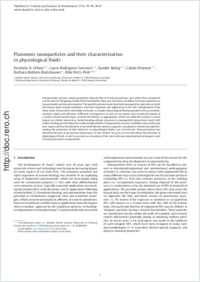Plasmonic nanoparticles and their characterization in physiological fluids
- Urban, Dominic A. Adolphe Merkle Insitute, University of Fribourg, Switzerland
- Rodriguez-Lorenzo, Laura Adolphe Merkle Insitute, University of Fribourg, Switzerland
- Balog, Sandor Adolphe Merkle Insitute, University of Fribourg, Switzerland
- Kinnear, Calum Adolphe Merkle Insitute, University of Fribourg, Switzerland
- Rothen-Rutishauser, Barbara Adolphe Merkle Insitute, University of Fribourg, Switzerland
- Petri-Fink, Alke Adolphe Merkle Insitute, University of Fribourg, Switzerland - Chemistry Department, University of Fribourg, Switzerland
-
01.01.2016
Published in:
- Colloids and Surfaces B: Biointerfaces. - 2016, vol. 137, p. 39–49
English
Nanoparticles possess unique properties beyond that of classical materials, and while these properties can be used for designing a dedicated functionality, they may also pose a problem to living organisms, to human health and the environment. The specific primary routes by which nanoparticles may interact with the human body include inhalation, injection, ingestion and application to the skin. Independent of the entry route, the particles inevitably encounter a complex physiological fluid populated with e.g. proteins, vitamins, lipids and salts/ions. Different consequences of such an encounter may include formation of a surface-bound protein layer, particle dissolution or aggregation, which are expected to have a crucial impact on cellular interaction. Understanding cellular responses to nanoparticle interactions starts with understanding particle behavior in physiological fluids. Nanoparticles are now available in practically any size, shape and functionalization, to promote distinct optical, magnetic, and physico-chemical properties, making the prediction of their behavior, in physiological fluids, not a trivial task. Characterization has therefore become of paramount importance. In this review, we give an overview about the diversity of physiological fluids as well as present an inventory of the most relevant experimental techniques used to study plasmonic nanoparticles.
- Faculty
- Faculté des sciences et de médecine
- Department
- Département de Chimie
- Language
-
- English
- Classification
- Biological sciences
- License
-
License undefined
- Identifiers
-
- RERO DOC 258837
- DOI 10.1016/j.colsurfb.2015.05.053
- Persistent URL
- https://folia.unifr.ch/unifr/documents/304700
Statistics
Document views: 136
File downloads:
- pdf: 290
